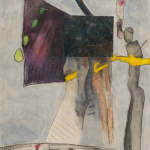Starry Night on the Somme, 1916

collage painting on Stonehenge grey paper
30 x 44
WWI series / $3000
Here the enemy had sat for two years, looking down on France and daily strengthening himself. His trebled and quadrupled lines of defense, worked for him by his prisoners, ran below and along the flanks and on the tops of ranges of five-hundred-foot downs. Some of these were studded with close woods, deadlier even than the fortified villages between them; some cut with narrowing valleys that drew machine-gun fire as chimneys draw draughts; some opening into broad, seemingly smooth slopes, whose every haunch and hollow covered sunken forts, carefully placed mine-fields, machine-gun pits, gigantic quarries, enlarged in the chalk, connecting with systems of catacomb-like dug-outs and subterranean works at all depths, in which brigades could lie until the fitting moment. Belt upon belt of fifty-yard-deep wire protected these points, either directly or at such angles as should herd and hold up attacking infantry to the fire of veiled guns. Nothing in the entire system had been neglected or unforeseen, except knowledge of the nature of the men who, in due time, should wear their red way through every yard of it.
– Rudyard Kipling, describing the advantageous German positions
during the British attack on the Somme, 1916


